Welcome to our guide to the 10 best beautiful places in Fujiyoshida, a city blessed with natural splendor and cultural richness, nestled in the shadow of the iconic Mount Fuji.
Fujiyoshida offers various attractions, from serene historical shrines and panoramic viewing platforms to thrilling amusement parks and tranquil natural settings.
Each spot provides a unique view of Mount Fuji and offers insight into the area’s deep cultural heritage.
Join us as we explore the stunning landscapes and cultural landmarks that make Fujiyoshida a must-visit destination for anyone traveling to Japan.
Whether you’re a nature lover, a culture enthusiast, or an adventure seeker, Fujiyoshida has something unique to offer.
- Recommended BEST Tours in Fujiyoshida
- Recommended Fujiyoshida Hotels
- Cheap Flights, Airline Tickets & Plane Tickets (TRIP.COM)
Number 10: Arakurayama Sengen Park.
Starting our countdown at number 10, Arakurayama Sengen Park epitomizes the picturesque beauty of Japan. This park is renowned for its Chureito Pagoda, a five-storied pagoda that stands as a peaceful monument against Mount Fuji’s breathtaking backdrop.
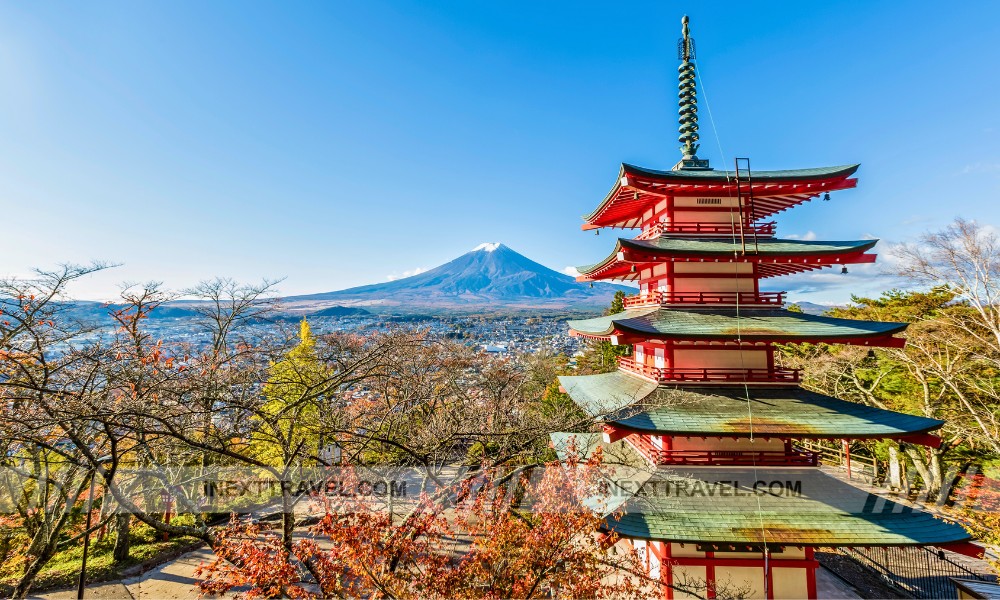
The park and pagoda are situated on the slopes of Mount Arakura and have become one of the most photographed locations in Japan, especially during the cherry blossom season in spring and the vibrant hues of autumn.
The journey to the pagoda is a scenic endeavor involving a climb up 398 steps. The pagoda is surrounded by lush greenery and, in the proper seasons, vibrant cherry blossoms or fiery autumn leaves. Each step offers a new angle and perspective of Mount Fuji, encouraging visitors to pause and soak in the stunning vistas.
The effort is rewarded with the sight of the elegant pagoda and a panoramic view encompassing the city of Fujiyoshida, the dense forests below, and the imposing beauty of Mount Fuji itself.
During the cherry blossom season, the area around Arakurayama Sengen Park becomes a festive spot, drawing crowds who come to partake in hanami, the traditional Japanese custom of enjoying the transient beauty of flowers. The cherry blossoms provide a delicate frame for the majestic Mount Fuji, creating a quintessentially Japanese scene that combines natural beauty with cultural significance.
In autumn, the landscape transforms as the leaves change color, offering a dramatically different but equally stunning visual experience, with the red and orange leaves complementing the stark white of Mount Fuji’s snow-capped peak.
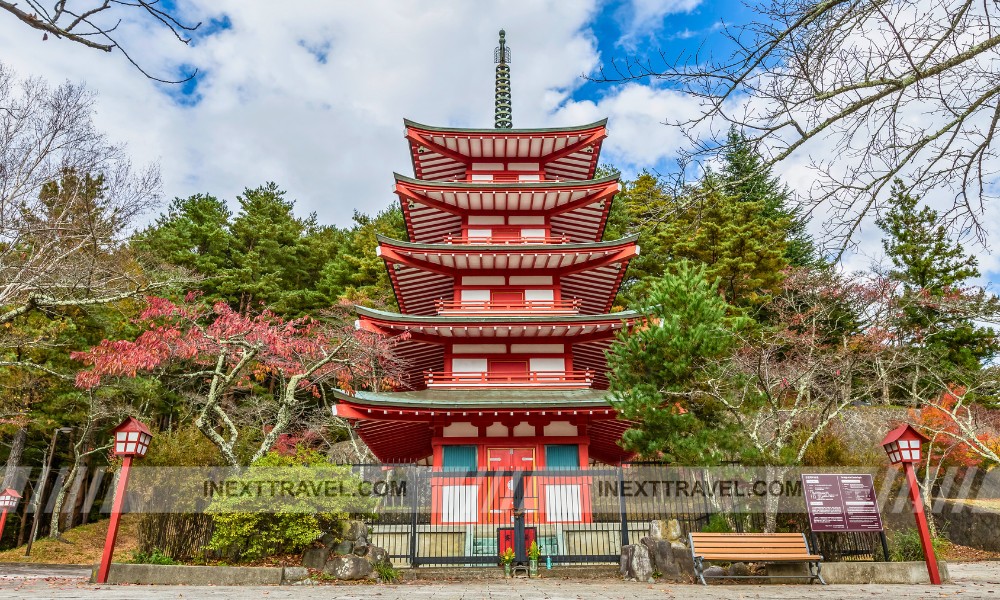
The park is not just a place for photography and sightseeing; it’s a cultural landmark, too. The Chureito Pagoda was built in 1963 as a peace memorial, commemorating the war dead, and adds a layer of historical depth to the visit. It stands as a symbol of peace and remembrance, its serene setting inviting contemplation and reflection.
Arakurayama Sengen Park offers a blend of natural beauty, cultural heritage, and historical significance, making it a must-visit location in Fujiyoshida. Whether you are a photographer, a nature enthusiast, or someone seeking to experience Japan’s iconic landscapes, this park provides a perfect starting point to explore the scenic and cultural richness of the region.
Number 9: Fuji-Q Highland.
At number 9, Fuji-Q Highland is a haven for thrill-seekers and a unique amusement park where extreme rides meet stunning natural scenery. Located near the base of Mount Fuji, Fuji-Q Highland offers some of the most exhilarating roller coasters and attractions in the world, each designed to give visitors a rush of adrenaline while providing incredible views of Japan’s most iconic mountain.
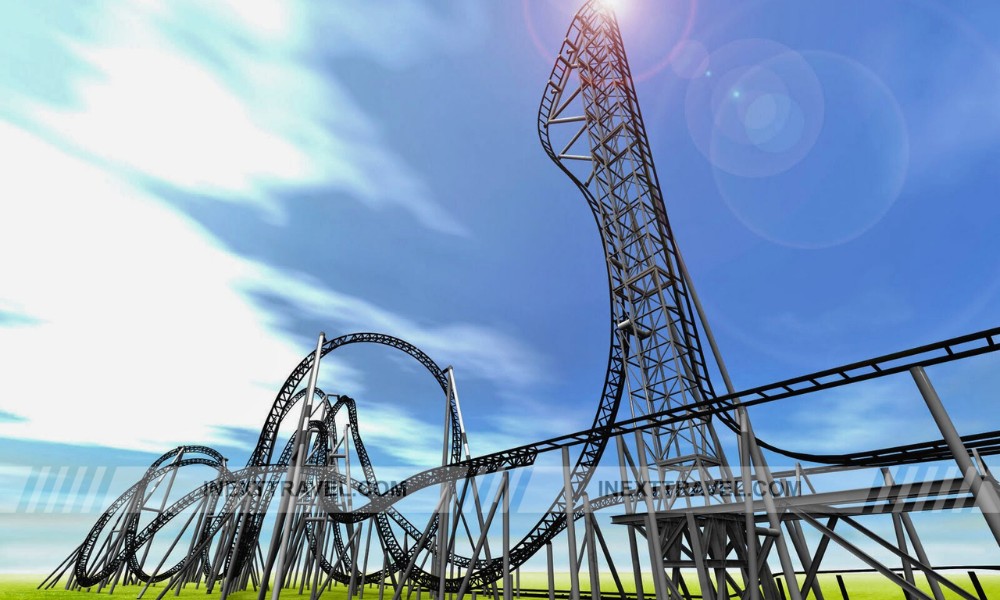
One of the park’s major draws is its record-breaking roller coasters. Rides like Fujiyama, dubbed the ‘King of Coasters,’ and Eejanaika, a fourth-dimension roller coaster with seats that rotate 360 degrees, offer high-speed thrills with dramatic drops and twists enhanced by the majestic backdrop of Mount Fuji.
“Dodonpa,” known for its intense speed and acceleration, shoots riders out at breakneck speeds, offering an extreme adrenaline rush. These attractions are not just about the thrill; the heights and speeds provide unique opportunities to see Mount Fuji from perspectives unavailable elsewhere.
But Fuji-Q Highland isn’t just for those with a taste for thrill rides. The park also caters to families and visitors of all ages and has many attractions. The park has themed areas dedicated to popular anime series, offering immersive experiences and slower rides suitable for younger visitors. It also features an array of haunted attractions, including the famous “Super Scary Labyrinth of Fear,” a haunted hospital-themed maze considered one of the most prolonged and most terrifying in the world.
Additionally, Fuji-Q Highland is known for its beautiful scenery. The park is meticulously landscaped with seasonal flowers and plants, making it a pleasant place to walk around and enjoy the fresh air and natural beauty. On clear days, the views of Mount Fuji are unparalleled, turning the park into a scenic viewing area where visitors can relax and take in the awe-inspiring sight.
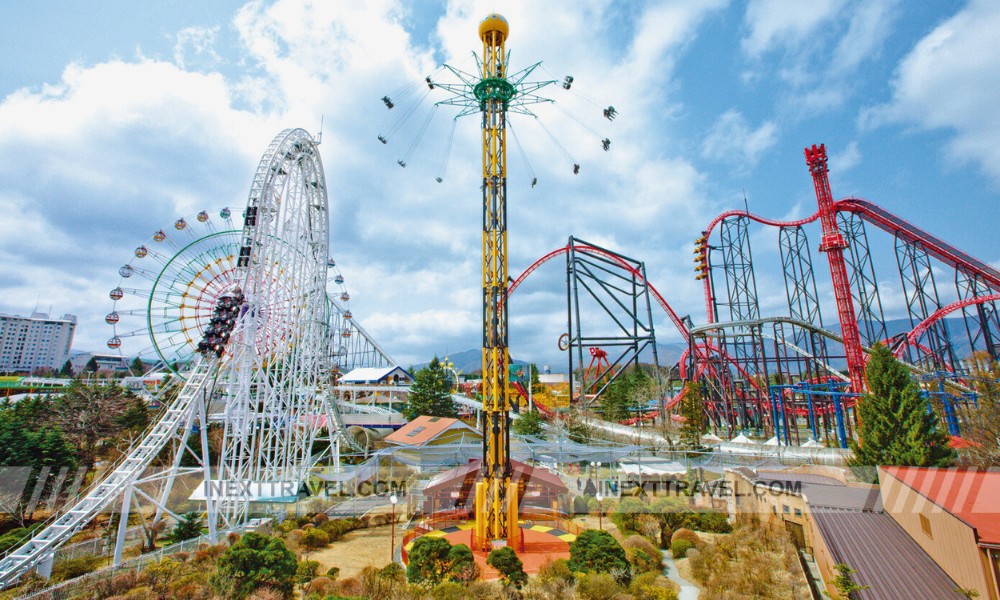
The park offers plenty of dining options for those looking for a break from the excitement, from quick snacks to sit-down meals featuring Japanese and international cuisine. There are also plenty of souvenir shops where visitors can pick up unique gifts and memorabilia related to the park and Mount Fuji.
In conclusion, Fuji-Q Highland offers a complete entertainment package combining cutting-edge thrill rides with spectacular natural beauty. Every visit brings new adventures and memories, making it a must-visit destination for families, thrill-seekers, and anyone wanting to add a dose of adrenaline to their sightseeing in Japan.
Number 8: Oshino Hakkai.
At number 8 is Oshino Hakkai, a picturesque village that captures the essence of Japan’s natural beauty and traditional culture. Nestled in the foothills of Mount Fuji, this charming location is renowned for its eight crystal-clear ponds, fed by snowmelt filtering down from the mountain through layers of volcanic rock. This natural filtration process creates pools of water that are so pure and clear that the Japanese government has designated them a natural monument.
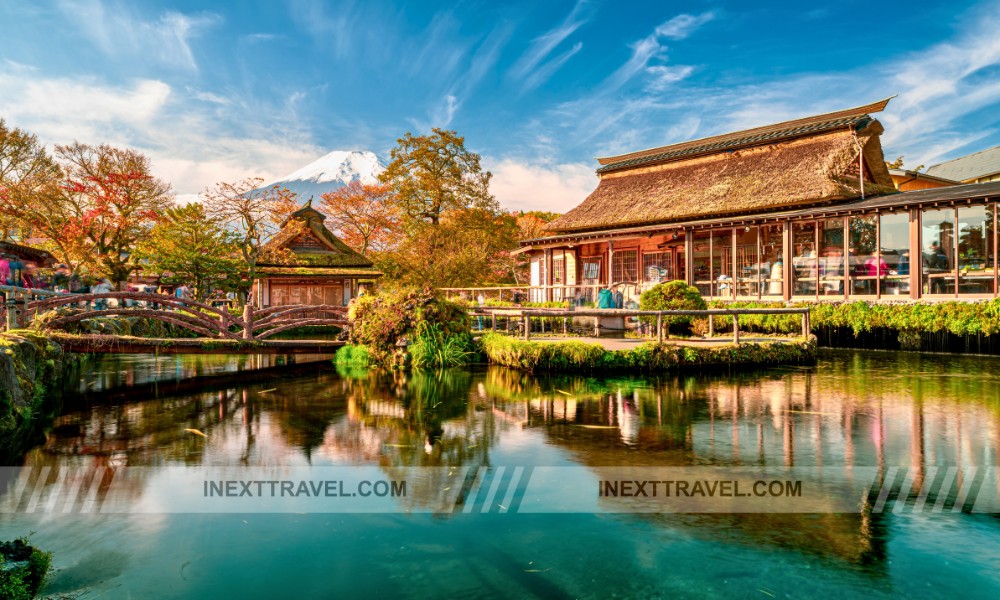
The eight ponds, each unique shape and character, are the village’s centerpiece. They are home to various aquatic plant life and fish, and their incredibly transparent waters allow visitors to see right down to the bottom, providing a magical underwater view.
The ponds are not just a beautiful natural feature; they are also steeped in history and legend and considered sacred by the local community. The water is believed to have purifying properties, adding a spiritual dimension to its breathtaking beauty.
Surrounding the ponds are quaint thatched-roof houses and several functioning water mills, preserving the region’s architectural style and traditional lifestyles. These structures add to the rustic charm of Oshino Hakkai, making visitors feel as though they have stepped back in time. The preservation of these buildings and the traditional farming implements displayed around the village offer insights into the historical rural life of Japan.
Oshino Hakkai is a haven for photographers and nature lovers where visitors can learn about traditional Japanese culture. The village hosts several small museums and souvenir shops that showcase local crafts, including intricate hand-made fabrics and regional culinary specialties. Snack stands also offer local treats like grilled mochi, providing a taste of the village’s culinary heritage.
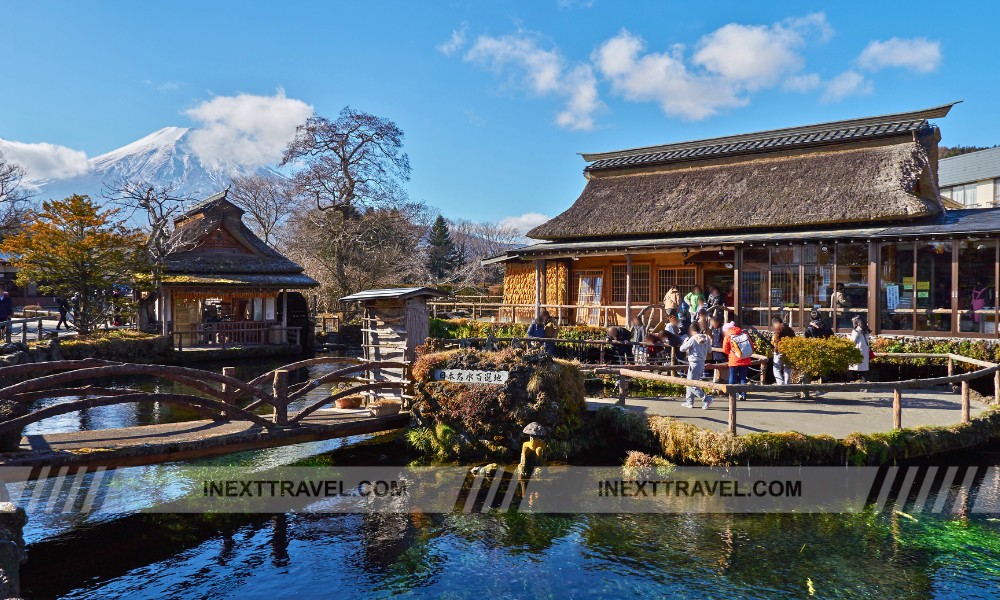
Walking paths around the ponds provide a peaceful setting for a stroll, inviting visitors to enjoy the serene atmosphere and natural beauty. Mount Fuji, visible from many points in the village, creates a stunning scenic view that enhances the peaceful experience of visiting Oshino Hakkai.
In conclusion, Oshino Hakkai is more than just a set of ponds; it is a cultural treasure where natural beauty, history, and traditional Japanese village life converge. This serene spot offers an escape from the hustle and bustle of modern life and a chance to connect with the tranquility and purity of nature, making it a must-visit for anyone traveling to the Fujiyoshida area.
Number 7: Kitaguchi Hongu Fuji Sengen Jinja Shrine.
At number 7, we find the Kitaguchi Hongu Fuji Sengen Jinja Shrine, a site of profound cultural and spiritual significance in the Fujiyoshida region. Established over 1,900 years ago, this ancient shrine serves as a venerable testament to Japan’s rich religious traditions and deep reverence for nature, particularly Mount Fuji, which has been worshipped as a sacred mountain for centuries.
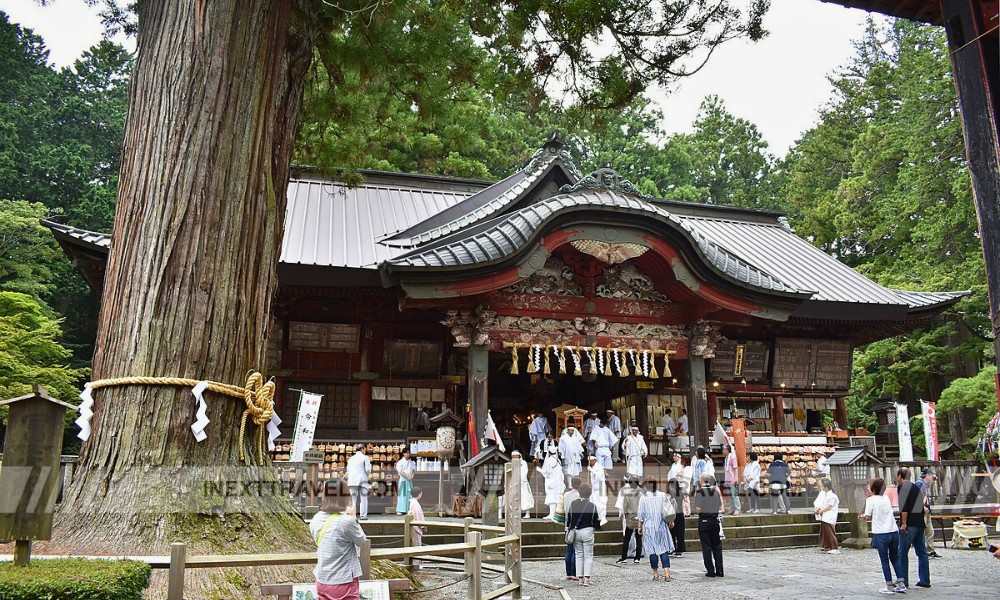
Kitaguchi Hongu Fuji Sengen Jinja Shrine is historically renowned as the traditional starting point for pilgrimages up Mount Fuji. Located at the northern base of the mountain, it is here that pilgrims have long begun their ascent, first paying respects and offering prayers for a safe journey.
The shrine is dedicated to Princess Konohanasakuya, the Shinto deity associated with Mount Fuji, embodying the blossom of trees and symbolizing the delicate but powerful nature of life and volcanoes.
The expansive shrine complex features a striking torii gate that marks the entrance to a different world of tranquility and timeless spiritual presence. The path to the main hall is flanked by majestic cedar trees, some centuries old. These trees create a dense forest canopy that filters the sunlight into ethereal patterns on the ground. This natural setting enhances the mystical atmosphere of the shrine, making a walk through its grounds feel like a passage through a sacred, otherworldly realm.
The architectural elements of the shrine are characteristic of Sengen shrines, which are found across the region dedicated to the deity of Mount Fuji. The vibrant red lacquered wood of the structures stands out against the lush green backdrop, adorned with intricate carvings and gold accents that reflect the craftsmanship and artistic heritage of Shinto shrine architecture.
Notably, the main hall and the water basin used for ritual cleansing are beautifully preserved, offering insight into the spiritual practices maintained for generations.
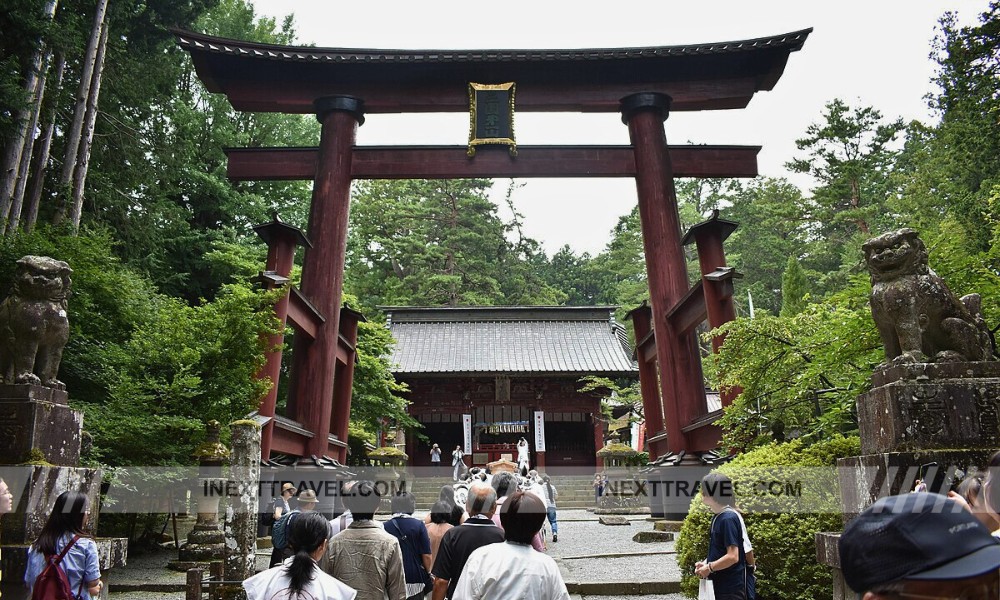
The shrine is a place for worship and a cultural hub, hosting several festivals throughout the year that draw visitors from all over Japan and beyond. These events, which often involve traditional music, dance, and rituals, provide a lively, engaging way to experience the local culture and religious practices first-hand.
In summary, Kitaguchi Hongu Fuji Sengen Jinja Shrine is more than just a point of departure for those climbing Mount Fuji—it is a cornerstone of the local community’s spiritual life and a captivating historical site.
The combination of its ancient heritage, stunning natural environment, and vibrant cultural expressions makes Fujiyoshida an essential destination for anyone visiting Fujiyoshida. It offers a unique glimpse into the soul of this storied region.
Number 6: Lake Kawaguchi.
At number 6 is Lake Kawaguchi, known as the most accessible and popular of the Fuji Five Lakes. Nestled in the stunning natural landscape near Mount Fuji, Lake Kawaguchi attracts visitors with its unparalleled views of the iconic volcano and its array of recreational activities that cater to adventure seekers and those looking for relaxation.
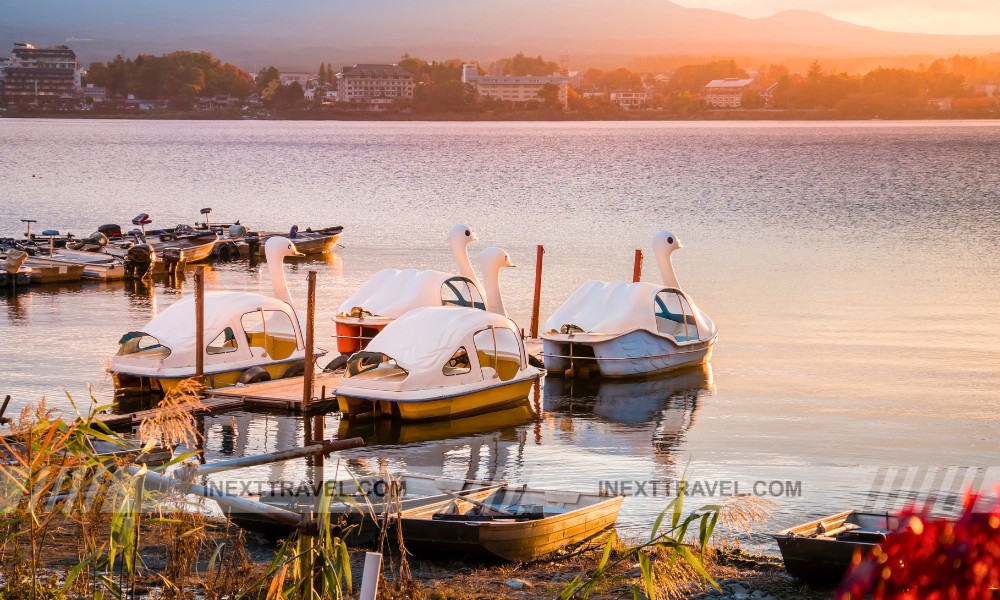
Lake Kawaguchi is a prime destination throughout the year. Its seasonal beauty transforms the area into a picturesque tableau that shifts from lush green summers to vibrant autumnal colors and into a serene, snowy wonderland in winter. Each season brings its unique charm, making it a year-round favorite for photographers, nature lovers, and travelers.
The tranquil waters of Lake Kawaguchi provide the perfect backdrop for those seeking relaxation. Numerous hotels, ryokans, and resorts line the shores, many featuring hot spring baths with views of Mount Fuji. Visitors can enjoy leisurely cruising on the lake, fishing, or simply strolling along the water’s edge. The surrounding area is also home to various cafes and restaurants where one can dine while appreciating the scenic vistas.
Adventure enthusiasts will also find plenty to do. The lake is a hub for outdoor sports, offering windsurfing, canoeing, and camping during the warmer months. Surrounding trails invite hikers and cyclists to explore more of the region’s natural beauty. In winter, the area becomes a gateway for snow sports, with several ski resorts just a short drive away.

Cultural activities also abound near Lake Kawaguchi. The area is rich with museums, such as the Kawaguchiko Music Forest, a European-style garden with music boxes and automated musical instruments, and the Itchiku Kubota Art Museum, renowned for its intricately dyed silk kimonos collection. Additionally, the lake hosts various festivals throughout the year, including a spectacular fireworks festival in the summer and a foliage festival in the fall.
In conclusion, Lake Kawaguchi is a versatile destination offering an idyllic mix of beauty, relaxation, and adventure. Its easy accessibility from major cities such as Tokyo makes it an ideal escape into nature, where the breathtaking landscapes and the clear, reflective waters create a peaceful yet stimulating environment for all who visit.
Whether you’re capturing the perfect photograph of Mount Fuji, soaking in a hot spring, or embarking on a lakeside adventure, Lake Kawaguchi promises memorable experiences that embody the essence of Japan’s natural and cultural richness.
Number 5: Fujiyama Museum.
At number 5 is the Fujiyama Museum, a cultural gem in the heart of Fujiyoshida. This museum is dedicated to celebrating and exploring Mount Fuji’s profound impact on Japanese art and culture.
Its impressive collection spans from classic ukiyo-e woodblock prints to modern artistic interpretations, illustrating the mountain’s timeless allure and significant role in Japanese aesthetics.
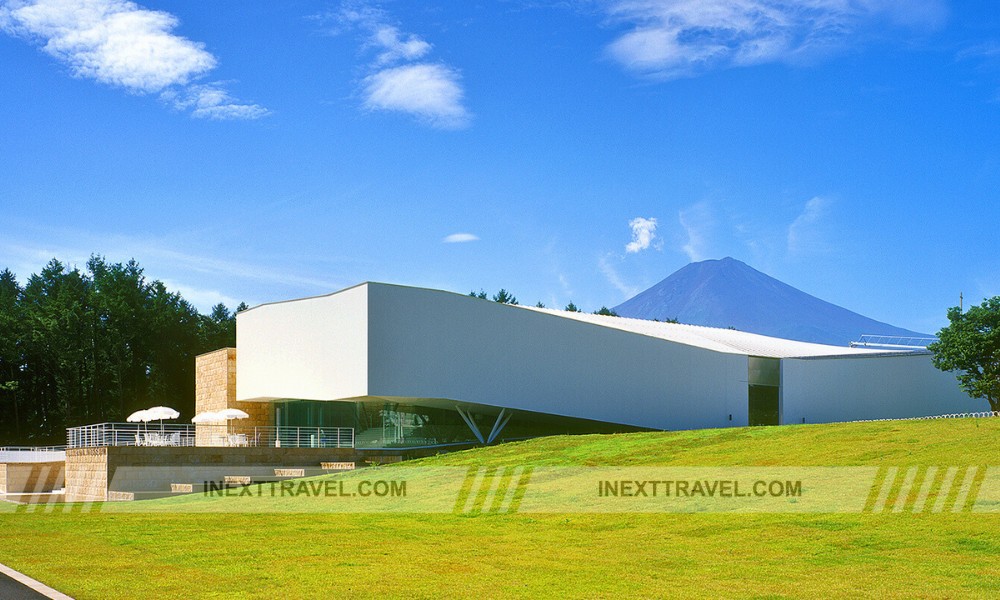
The Fujiyama Museum’s collection showcases how Mount Fuji has captivated artists for centuries. Among the highlights are historic ukiyo-e prints by famed artists like Hokusai and Hiroshige, whose iconic works have immortalized Mount Fuji’s majestic silhouette.
These prints depict the mountain from various perspectives and seasons and reflect the everyday life and travels of the Japanese during the Edo period, emphasizing Mount Fuji’s omnipresence in Japan’s cultural and physical landscape.
In addition to these historical pieces, the museum also features contemporary works from artists who continue to draw inspiration from Mount Fuji. These modern interpretations, whether through photography, painting, or mixed media, speak to the ongoing dialogue between the artists and this iconic natural landmark.
They explore themes of beauty, permanence, and the interplay between nature and human perception, further enriching Mount Fuji’s narrative as a national identity symbol.
The Fujiyama Museum does more than display art; it offers an educational journey through the history of Mount Fuji’s representation in Japanese art. The museum highlights how Mount Fuji has been a source of spiritual inspiration and artistic challenge through its exhibitions. It also delves into the mountain’s influence on Japanese culture and tourism, showcasing its role in pilgrimage traditions and its global recognition as a symbol of Japan.
Visitors to the Fujiyama Museum can also enjoy interactive displays and seasonal exhibitions that offer deeper insights into specific aspects or periods of artistic production related to Mount Fuji.
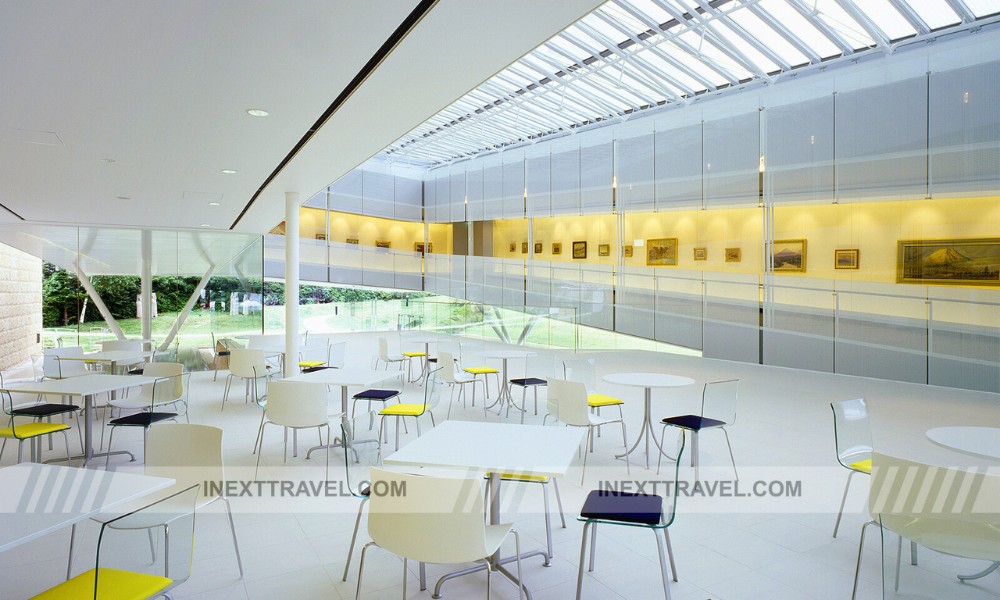
These features make the museum a treasure trove for art lovers and historians and an engaging visitor experience. They provide a deeper understanding of why Mount Fuji remains such an enduring and influential icon in Japan and worldwide.
Overall, the Fujiyama Museum serves as a testament to Mount Fuji’s enduring beauty and cultural significance, offering a space where historical and contemporary conversations about this iconic peak resonate.
For anyone visiting Fujiyoshida, a trip to the Fujiyama Museum is an essential experience, providing a profound appreciation for one of Japan’s most beloved and celebrated symbols.
Number 4: Panoramic Viewing Platform.
At number 4, we have the Panoramic Viewing Platform, a spectacular feature within the Fuji-Q Highland amusement park. This platform offers a unique and stunning 360-degree view that encapsulates the breathtaking beauty of the surrounding landscape, with Mount Fuji as the crowning jewel in its scenic panorama.
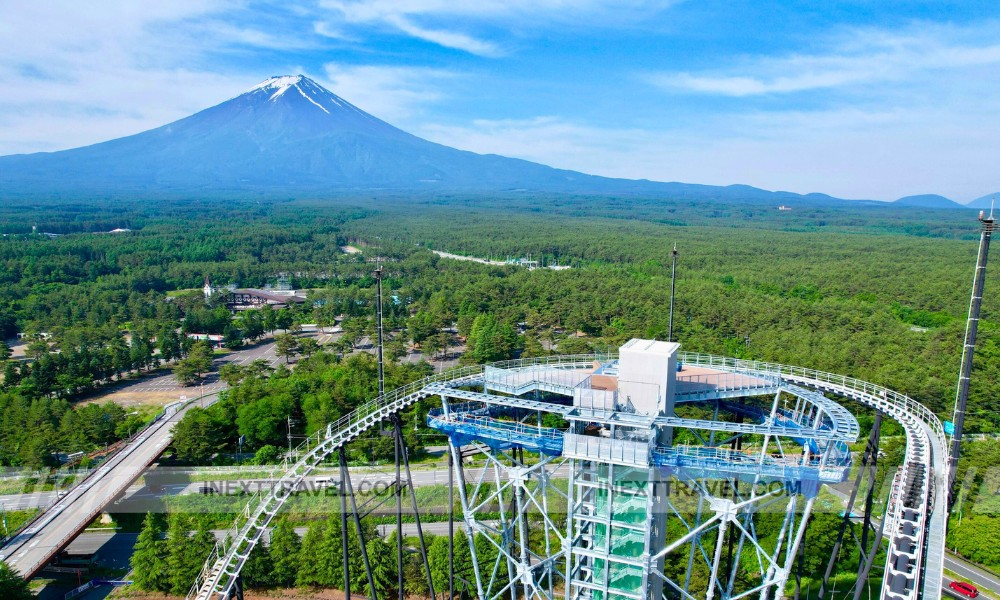
Positioned strategically within the park, the Panoramic Viewing Platform allows visitors to rise above the excitement of the rides and attractions, offering a moment of serene contemplation amid the thrills.
From this elevated vantage point, guests can witness Mount Fuji’s full majesty, its iconic, snow-capped peak in all its glory. The platform provides an unparalleled opportunity to see Fuji’s perfect symmetrical form, which has inspired artists, poets, and travelers for centuries.
The views from the platform extend beyond just Mount Fuji. Visitors can gaze out over the lush forests, rolling hills, and the rural beauty of the Yamanashi Prefecture.
On clear days, the view encompasses the nearby lakes and other peaks in the Fuji Five Lakes region, creating a breathtaking panorama that encapsulates Japan’s natural beauty.
This panoramic experience is not just visual; it’s designed to be immersive, providing interpretive panels that explain the geographical and cultural significance of the sights below.
The platform offers a perfect spot for photography enthusiasts and nature lovers to capture stunning landscapes. At the same time, families and couples can enjoy the rare opportunity to take in such an expansive view together.
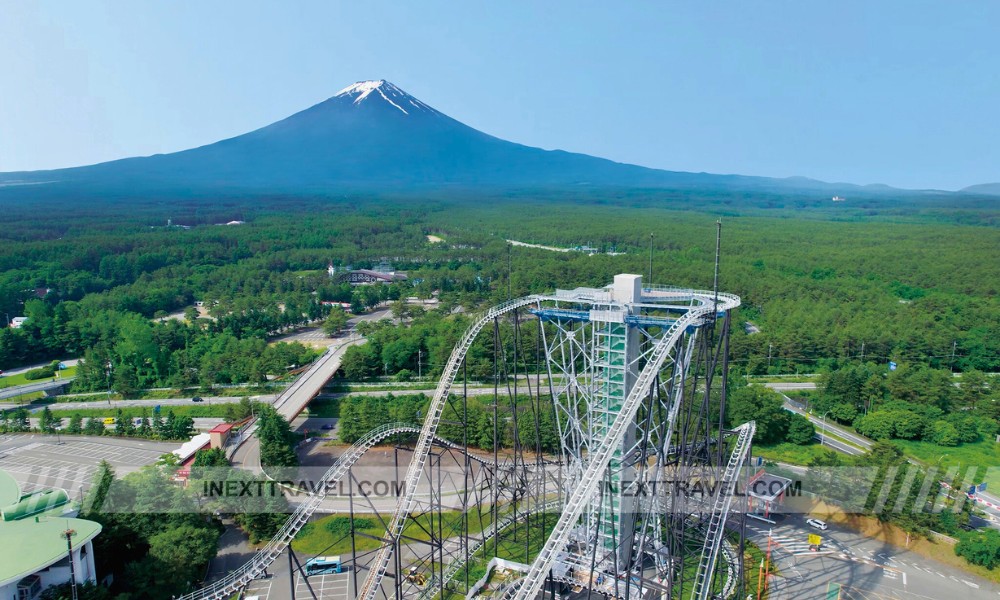
Furthermore, the viewing platform is designed to be accessible and welcoming to all visitors, ensuring everyone can enjoy the spectacular views regardless of age or physical ability.
Whether you are visiting Fuji-Q Highland for its exciting rides or as a scenic escape, the Panoramic Viewing Platform adds a dimension of awe and beauty to your visit, making it a must-see destination within the park.
In summary, the Panoramic Viewing Platform at Fuji-Q Highland is more than just an observation deck; it is a gateway to experiencing the grandeur of Mount Fuji and the surrounding area breathtakingly and memorably. It invites visitors to pause, reflect, and admire the natural wonders of Japan from an extraordinary perspective.
Number 3: Yoshida Trail.
At number 3, we have the Yoshida Trail, the most popular and historically significant route for ascending Mount Fuji. Starting in Fujiyoshida, this trail is a favorite among climbers for its accessibility and the comprehensive facilities that line the path to the summit.
The Yoshida Trail is not just a hiking route but a journey through natural beauty and historical legacy, offering an unforgettable experience for those who take on its challenge.
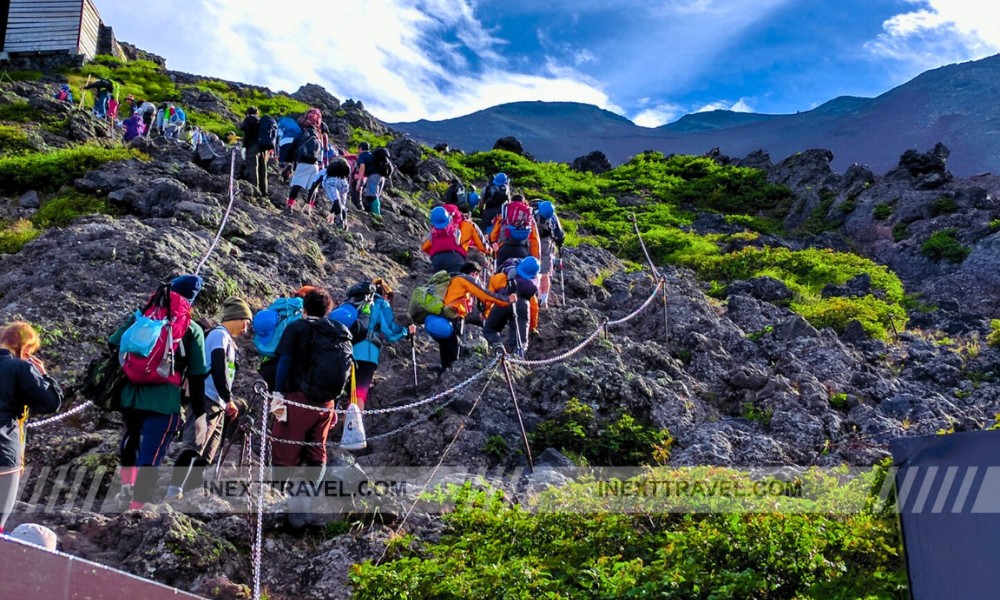
The trail is approximately 19 kilometers round trip and features a well-maintained path that has guided pilgrims and adventure seekers for centuries. The route is dotted with historic stations—each providing various amenities such as resting spots, food services, and overnight accommodations.
These stations make the Yoshida Trail manageable for a wide range of hikers, from novices to experienced climbers. Each station’s unique character and history is often filled with charms and relics that speak to the mountain’s spiritual significance.
As climbers ascend the trail, they are rewarded with stunning vistas that change dramatically with the altitude. The lower stations offer lush forest views that gradually open up to sweeping landscapes of the surrounding countryside and other parts of the Fuji Five Lakes area. Higher up, the vegetation thins and the terrain becomes more volcanic, with panoramic sky views and clouds often below the peak’s altitude.
The real reward comes at the summit, where hikers experience the sunrise from above the clouds—a spiritual and awe-inspiring moment known as “Goraiko.” Watching the sunrise from the top of Japan’s highest peak is considered a once-in-a-lifetime experience that embodies the triumph of the climb and the profound beauty of nature.
Climbing Mount Fuji via the Yoshida Trail is a physical challenge and a cultural experience. The trail’s history as a pilgrimage route adds depth to the hike, inviting climbers to partake in a centuries-old tradition of reverence and reflection. Safety stations and experienced guides are available to ensure the journey is as safe as it is rewarding.
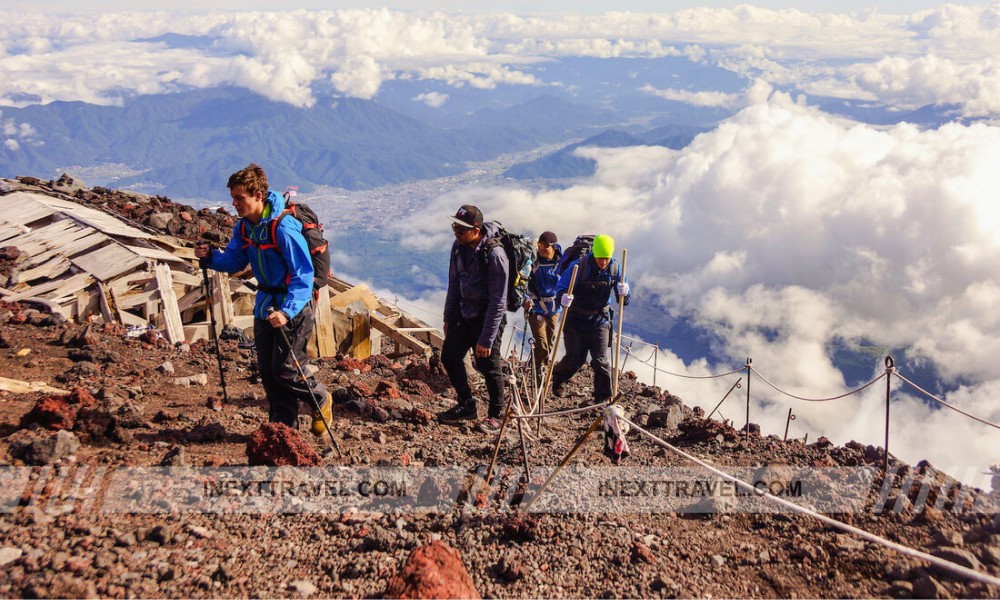
In conclusion, the Yoshida Trail offers more than just a climb; it provides a pathway through history, culture, and natural wonder, making it a must-do for anyone visiting Fujiyoshida.
Whether you are seeking the physical challenge of climbing Japan’s most famous mountain or the spiritual fulfillment of a pilgrimage, the Yoshida Trail delivers an unparalleled experience that leaves hikers with a sense of accomplishment and awe.
Number 2: Fujiyoshida City Art Museum.
Coming in at number 2 is the Fujiyoshida City Art Museum, a cultural institution deeply rooted in the local community and dedicated to preserving and celebrating the rich artistic heritage of Fujiyoshida and the surrounding region.
This museum showcases the artistic achievements of local and regional artists and serves as a vibrant center of cultural exchange and learning. Its compelling exhibits provide insights into the city’s historical narrative.
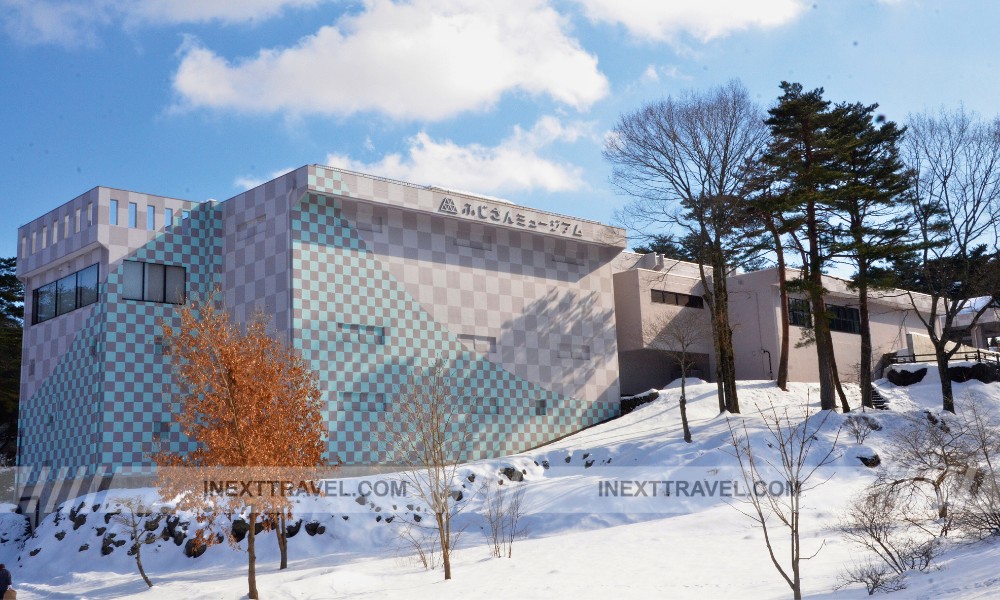
The Fujiyoshida City Art Museum offers a curated selection of works that span traditional and contemporary art forms. The museum’s collection includes a wide range of mediums, from painting and sculpture to crafts and photography, each piece thoughtfully displayed to tell the story of the region’s cultural evolution. Particular emphasis is given to works that depict or are inspired by Mount Fuji, highlighting the mountain’s significant influence on artists across generations.
These pieces range from classical portrayals in ukiyo-e prints to modern interpretations in various art styles, reflecting the ongoing dialogue between the mountain and the artists it inspires.
In addition to its permanent collection, the museum hosts temporary exhibitions that explore specific themes or highlight particular artists, including emerging talents from the local community.
These exhibitions are designed to entertain and educate and to foster a deeper understanding and appreciation of the arts within the community. By showcasing local artists, the museum plays a crucial role in nurturing the region’s cultural ecosystem and ensuring that the arts continue to thrive and evolve.
The museum also offers educational programs and workshops for visitors of all ages, from schoolchildren to adults. These programs are often hands-on, allowing participants to engage directly with artistic techniques and concepts, enriching the visitor experience and providing more profound engagement with the art on display.
Architecturally, the Fujiyoshida City Art Museum itself is a testament to thoughtful design. Its functional and aesthetically pleasing spaces ensure the art is the focal point.
The building’s layout encourages a flow that guides visitors through the exhibits logically and enrichingly, while large windows provide natural light that enhances the viewing experience.

In conclusion, the Fujiyoshida City Art Museum is more than just a repository of art; it is a living, breathing space that actively contributes to the cultural life of Fujiyoshida. It provides a window into the past, a reflection of the present, and a vision of the future of the region’s artistic endeavors.
For anyone visiting Fujiyoshida, a trip to this museum offers a profound look at the local culture, artistic heritage, and community identity, making it a must-visit destination for art lovers and cultural explorers alike.
Number 1: Mount Fuji.
At number 1, undoubtedly, stands Mount Fuji, a symbolic and majestic natural landmark that is synonymous with Japan’s cultural and spiritual identity. Visible from almost every corner of Fujiyoshida, this iconic mountain is not merely a geological wonder but a profound symbol revered throughout Japanese history and an inspiration for countless works of art, literature, and religious devotion.
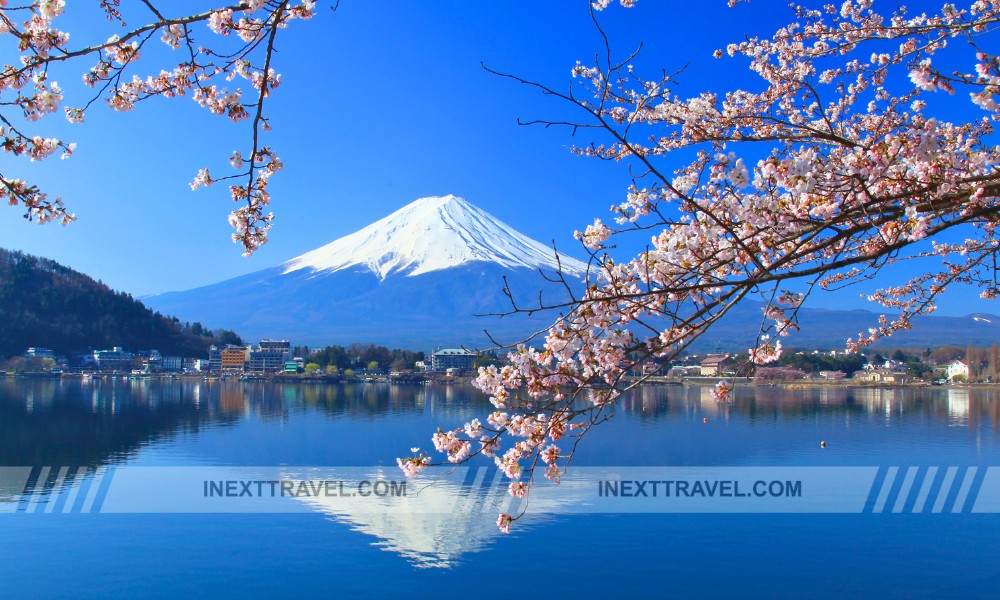
Mount Fuji’s imposing presence and nearly perfect symmetrical cone shape, capped with snow for several months of the year, make it an awe-inspiring sight. Its beauty and grandeur have made it a pilgrimage site for centuries, not only for devout practitioners of Shinto and Buddhist beliefs but also for hikers and nature enthusiasts worldwide.
Climbing Mount Fuji, especially to witness the sunrise from its summit—a practice known as “Goraiko”—is considered a once-in-a-lifetime experience that offers panoramic views, spiritual cleansing, and renewal.
Mount Fuji’s cultural significance extends beyond its physical beauty. It has been registered as a UNESCO World Heritage Site for its striking natural features and historical and artistic importance.
Known as Fuji-san in Japanese, it is featured prominently in the ukiyo-e woodblock prints of the Edo period, notably in the series “Thirty-six Views of Mount Fuji” by Hokusai. These images have played a crucial role in disseminating the iconic image of Fuji across Japan and around the globe, cementing its status as a national symbol.
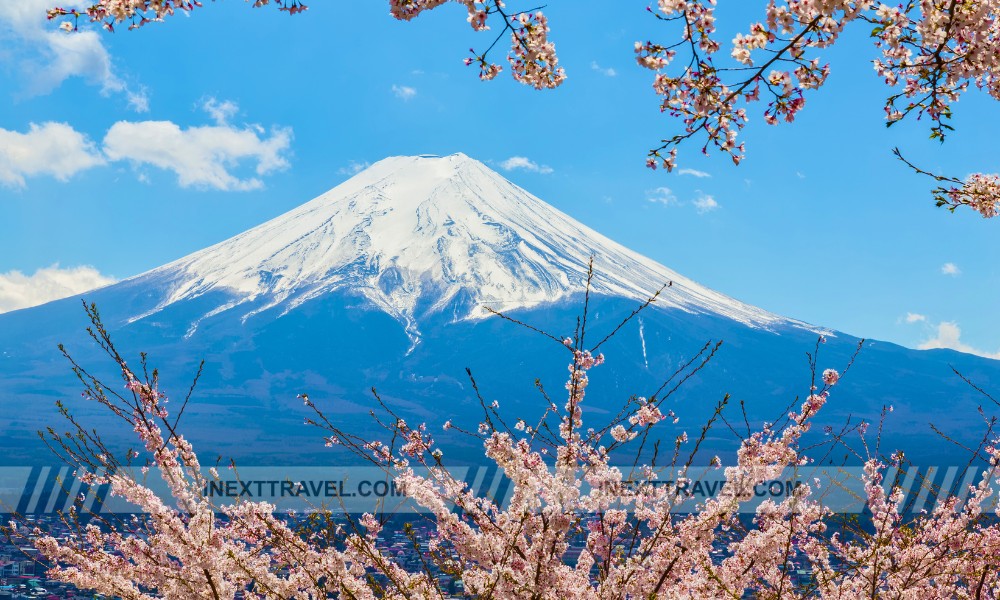
Furthermore, the mountain influences the daily life and practices of the people living in its shadow. Local festivals, museum exhibitions, and art forms in Fujiyoshida and surrounding areas often celebrate or reference the mountain, underscoring its integral role in local culture and identity.
The environmental conditions influenced by Mount Fuji also contribute to the area’s agriculture, including the cultivation of distinctive crops like Fujizakura cherries and Shizuoka tea, which are celebrated for their unique flavors.
In summary, Mount Fuji is much more than just Japan’s highest peak; it is a cornerstone of Japanese identity and a source of inspiration and spiritual solace for millions. For visitors to Fujiyoshida, it offers spectacular scenic beauty and a deep, resonant connection to the cultural heart of Japan. Its ever-present, serene, yet commanding aspect makes it the ultimate destination, genuinely deserving of its place as the most beautiful place in Fujiyoshida.
Conclusion
As we conclude our tour of the ten best beautiful places in Fujiyoshida, it’s clear that this city is a treasure trove of natural beauty and cultural richness.
Each location we’ve explored offers a unique perspective on the majestic Mount Fuji and provides a deep connection to the area’s historical and cultural fabric.
From the breathtaking views at the Panoramic Viewing Platform to the spiritual serenity of the Kitaguchi Hongu Fuji Sengen Jinja Shrine, Fujiyoshida presents a remarkable array of experiences that blend the natural with the culture.
Fujiyoshida’s landscapes invite visitors to observe and participate in the area’s rich traditions, whether through a peaceful stroll in Oshino Hakkai or an exhilarating ride at Fuji-Q Highland.
The city serves as a gateway to the revered Mount Fuji, offering literal and metaphorical pathways to explore this iconic symbol of Japan.
We hope this guide inspires you to visit Fujiyoshida and experience its beauty firsthand.
Each destination in our list promises memorable sights and experiences that will enrich your understanding and appreciation of this spectacular region of Japan.
Whether you are capturing the perfect photo, enjoying a quiet moment of reflection, or embarking on an adventurous climb, Fujiyoshida is a place where memories are made and the spirit of Japan is palpably felt.